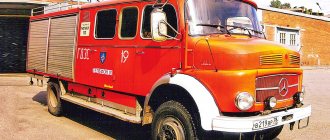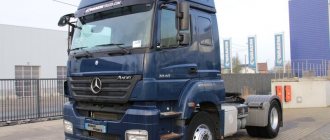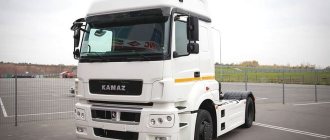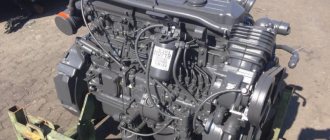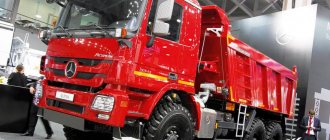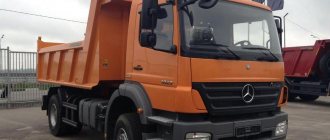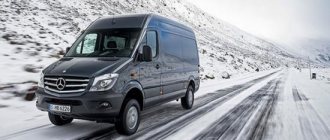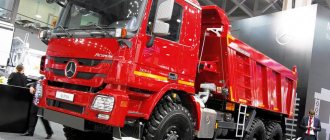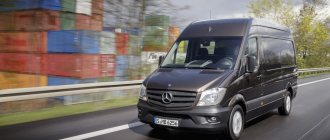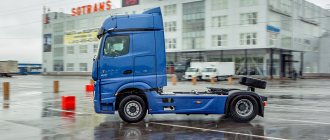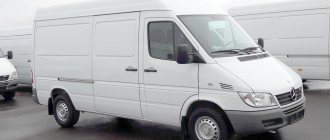| On June 28, 1926, the two oldest German automobile companies merged - Daimler-Motoren-Gesellschaft from Stuttgart and Benz and Daimler-Benz AG, which produces well-known cars of the brand " Mercedes Benz". Immediately after the merger, trucks were manufactured only at the former Benz plant in Gaggenau, and were temporarily not used in Mannheim and Marienfeld. After the merger, practically nothing remained from the previous programs of both partners. The outdated “DC/DR” range was eliminated, and the only reminder of Benz was the 5-ton Mercedes-Benz L5 truck (formerly Benz 5CN) with a 70-horsepower engine. Already in 1926, a new range was launched. At first it included two models “L1” and “12” with a load capacity of 1.0 and 2.5 tons with gasoline engines of 50-55 hp, a 3-speed gearbox, cardan drive and pneumatic tires. In 1927, a 5-ton 3-axle truck “N5” (6x4) with a 6-cylinder 100-horsepower engine, brakes on all wheels and a compressor for inflating tires appeared, as well as a low-loader semi-hood chassis “NJ5” for garbage trucks and firefighters cars From the first days of the new company's existence, standard indexing of models was introduced. Flatbed trucks received the index “L” with a digital indicator of their carrying capacity in tons, dump trucks - “K”, all-wheel drive versions - “A”, buses - “O”, and later cabover versions and truck tractors had the indices “P” and “S” " Since 1929, the single digit in the marking was replaced by a four-digit number. Now the range consisted of seven basic models from “L1000” to “L5000” with a carrying capacity from 750 kg to 5 tons, equipped with six-cylinder carburetor engines with a power of 48-110 hp. After the brief oblivion of the diesel engine, which appeared on the Benz truck in 1924, work in this direction was continued by Daimler-Benz designers Hans Nibel and Friedrich Nallinger. At their request, in 1927, Robert Bosch developed a new nozzle and improved the process of pre-chamber mixture formation. Following the model of the Benz engine, all subsequent Daimler-Benz diesel engines that ran on low-grade petroleum fuel, so-called heavy oils, received the index “OM” - short for “Olmotor” (Olmotor - oil or petroleum engine). The first proprietary diesel engine “OM5” was a 6-cylinder pre-chamber (8550 cm3, 60 hp at 1300 rpm) and had a mass of 630 kg. In 1928, it was installed on a 3-axle truck “N56” (6x4) with a cardan drive on both rear axles, reaching a speed of 45 km/h. The huge costs of developing diesel engines and the low demand for such vehicles gave rise to a negative attitude towards them among the company's management. Until 1932, diesel engines were used mainly on 5-ton L5000 vehicles, and for heavier ones they used a Maybach V12 gasoline engine with a power of 150 hp. Crisis of the late 20s. forced Daimler-Benz to reduce production from 3,800 to 1,600 trucks. By the end of 1930, the situation was corrected by introducing the inexpensive “Lo2000/2500” range for urban transport. It used unified gasoline and diesel engines of the OM59 series (3760 cm3), which had the same power of 55 hp. With. and proven the advantages of the latter: the diesel consumed 13 liters of fuel, the gasoline version -22 liters per 100 km. Not without significant financial assistance from Daimler-Benz, Adolf Hitler came to power, facilitating the issuance of large government contracts to him, accompanied by lucrative benefits. This led to its rapid transformation into the largest German engineering concern. Already since 1933, its activities and program were actually determined by a representative of the National Socialist Party, introduced to the board of the concern. In 1933, the next diesel trucks “Lo2750” and “Lo3500” (65-95 hp) appeared in the Daimler-Benz program, and an 8-cylinder diesel engine with a power of 150~200 hp was tested on the latter, for the first time received a volumetric supercharger “Roots”. A year later, the L5000 car appeared with a 10-liter OM79 diesel engine producing 120 hp. and a 5-speed gearbox. In 1934, 5,600 trucks were manufactured, and from 1935 the Mannheim plant began operating, producing all-wheel drive models “LA3000/4500” (4x4). The reconstructed Marienfeld plant also began production of the "LG40IO" cross-country vehicle with a 100-horsepower diesel engine and an 8-speed gearbox. In the mid-30s. production began of a new range of 1-4 tons (models from “L1100” to “L3750”) with carburetor or diesel engines of 45-95 hp, as well as a heavy family that included 2- and 3-axle models “L6500” , "L8500" and 17-ton "L10000" (6x4) with a wheelbase of 5750 mm and all single tires. The latter was equipped with 6-cylinder 150-horsepower diesel engines “OM54” or “OM57” (11.2 and 12.5 l) and a 4-speed gearbox, had a mass of 7.5 tons and a speed of 75 km/h. On the basis of the family, “LK” dump trucks and “LZ” ballast tractors with a shortened wheelbase (3150-3650 mm) were created. By 1937, the Daimler-Benz concern, having produced about 10 thousand trucks, became the largest manufacturer of diesel vehicles in Germany and became a leader among European companies. New in 1937 was the 1.5-ton L1500 truck, produced in Mannheim. It was offered with a 2.2-liter gasoline engine producing 45 hp. or the new 4-cylinder diesel engine “OM138” (2545 cm3, 47 hp) and a 4-speed gearbox from serial Mercedes-Benz passenger cars. It developed the highest speed among Mercedes trucks - 80 km/h. At the same time, production of the updated “L2000”, “L2500” and “L3000” series with different types of engines of 60-100 hp began. By 1939, the program consisted exclusively of diesel and gas generator vehicles with a lifting capacity of 3.0-6.5 tons. From the mid-30s. Daimler-Benz has sharply intensified work on military equipment. In 1938, the production of army vehicles exceeded the production of civilian trucks, and since 1940, almost all production was transferred to the manufacture of military products. In 1941, the last civilian truck, the L4500S, appeared with an OM67/4 diesel engine of 112 hp, a 5-speed gearbox and a combined braking system: the front wheels had a hydraulic drive, the rear wheels had a pneumatic drive. During the war, Daimler-Benz produced army versions of civilian vehicles "L1500A" (4x4) and "L4500", and in 1942, assembly of the 3-ton truck "L701" with a 68-horsepower gasoline engine began in Mannheim - an analogue car "Opel Blitz" (Opel Blitz). The concern's factories also produced half-track armored personnel carriers and tractors, tanks of all series, including the heavy Panther, self-propelled artillery mounts and aircraft engines. At the end of the war, all Daimler-Benz enterprises were heavily damaged by bombing and ground combat. The factories in Sindelfingen, Untertürkheim and Gaggenau were destroyed by 70-85% and lost 50-70% of their machine park. The Mannheim plant suffered only 20% damage, but the factories near Berlin were wiped off the face of the earth. However, the catastrophic results were reduced because shortly before the end of the war, the most important and expensive equipment was hidden in secret storerooms - in mine adits, caves and railway tunnels. In the first post-war period, car repairs were carried out in the surviving workshops for the occupation authorities. Already in the summer of 1945, the assembly of L701 trucks resumed in Mannheim. Almost simultaneously, the workshops in Gaggenau began operating, where they assembled the pre-war L4500S. In 1948, in Untertürkheim, engineer Wilhelm Haspel developed the first post-war truck "L3250" with a high-speed pre-chamber 6-cylinder 4.6-liter diesel engine "OM312" with 90 hp, created on the basis of an old gasoline engine from " Opel Blitz. The car had a welded frame made of steel profiles, a 5-speed gearbox and hydraulic drive of all brakes. Despite the haste of work, the truck turned out to be very successful and served as the basis for a whole family that was produced for about 20 years. In 1949, it was headed by the 3.5-ton L3500, to which two years later all-wheel drive options were added - the LA3500 flatbed, the LAK3500 dump truck and the LAF3500 firefighting chassis (4x4). In 1950~53 this range was continued by the more powerful machines “L4500”, “L5500” and “L6500”, produced in Gaggenau and Marienfeld. They were equipped with new 6-cylinder engines producing 100″145 hp. and an inclined chrome radiator trim. The L6500 was especially successful, pushing the products of its main competitors, Hens-chel and Krupp, out of the market. Its 8.3-liter OM315 engine, which was distinguished by very low noise, was installed on rubber cushions, the new 6-speed gearbox had synchronizers, and the driver’s seat was adjustable longitudinally for the first time. The car developed a speed quite high for its class - 70 km/h. Since 1952, its reinforced version “L6600” with an enlarged cabin for long-distance flights was produced, recognized as one of the most beautiful and comfortable heavy vehicles in Germany. At the same time, the Daimler-Benz program included the universal Unimog 4x4 chassis with a 25 hp engine. pp., the history of which is devoted to a separate chapter of the encyclopedia. The year 1954 is considered the starting point for the future diverse Mercedes-Benz truck program. It all started with a slight modernization and renaming of the previous series. The four base models from "L3500" to "L6600" received three-digit numeric indices "L311", "L312", "L325" and "L315", respectively, indicating the type of engine installed on them. The design of the vehicles remained virtually unchanged, but over time their load capacity and power increased, and options appeared with a cab over the “LP” engine and with all-wheel drive “LA”. In 1954, a turbocharger appeared for the first time on the 4.6-liter diesel engine of the L311F firefighting chassis, increasing power from 100 to 115 hp. Since 1956, lightweight 6.5-ton, 145-horsepower trucks have been produced - the hooded “L329” and the hoodless “LP329”. In the same year, the birth of the new most powerful series “L/LP326” with a lifting capacity of 8.6-9.2 tons, equipped with a diesel engine “OM326” (10809 cm3, 192-200 hp) with four overhead valves per cylinder took place. , fully synchronized gearbox with pneumatic control and power steering. Since 1958, this engine has been used on a rather remarkable car - the 9-ton 3-axle model "LP333" (6x2) with a spacious cabin above the engine and two front steering axles. It had exceptional stability and reached a speed of 90 km/h. Two years later, this original design was replaced by the classic 2-axle “LP334” vehicles, capable of operating as part of road trains with a gross weight of 32 tons. In total, 1833 copies of the “333” series vehicles were produced. The 5-ton army truck "LG315" (4x4) was produced in Gaggenau, for the first time equipped with a multi-fuel version of the 8.3-liter 145-horsepower engine. The greatest success was with the L311/L312 series and its successors, of which 175 thousand were built. About 50 thousand copies of heavy vehicles “L315/L325” were produced. In the 50s Light trucks on the chassis of serial Mercedes-Benz passenger cars for transporting 350-500 kg of small cargo have become very popular. The greatest success was achieved by pickups and vans based on the 170D and 170DS passenger cars, equipped with a 1.7-liter 40 hp diesel engine. Since 1955, Daimler-Benz entered the fight in the market of light trucks with a gross weight of up to 3.5 tons. The founder of the new family was the compact 1.75-ton cabover van “L319D” with a monocoque body, distinguished by its original appearance with elliptical headlights and front wheels moved forward. The onboard versions and chassis with cab were equipped with a spar frame. Their OM636 diesel engine (1767 cm3, 43 hp) was borrowed from the 180D passenger car series, and the principle of installing the entire power unit and front axle on an additional subframe was already used in passenger cars. Since 1957, the L319 model was equipped with a 1.9-liter carburetor engine producing 65 hp. from the new passenger car series “190”. All cars in the “319” range were equipped with a synchronized 4-speed gearbox, hypoid final drive, solid axles on leaf springs, hydraulic brakes and rack and pinion steering. Since 1961, their power has increased to 50 and 68 hp. accordingly, providing a maximum speed of 95 km/h. In the diesel version, fuel consumption was only 8.5 liters per 100 km. The demand for an inexpensive, maneuverable and economical car was so high that in 1958 its mass production was launched at the former (Auto Union) in Düsseldorf. Until 1967, 107 thousand copies were produced. In the early 60s. the Mercedes cargo program consisted of three dozen 2- and 3-axle vehicles with a carrying capacity from 1.75 to 15 tons with engines with a power of 45-200 hp, making up seven basic families and recognized as one of the most advanced in the world. Mercedes-Benz trucks were exported to almost 100 countries around the world. Assembly branches were opened in Spain, Brazil, Argentina and Australia, and licensed production began in India (Tata). The next turn in the history of Daimler-Benz occurred in 1963, when the introduction of unified families of different classes began, made using a modular method and distinguished by a more attractive appearance in a single corporate style. Hooded models received a massive alligator lining, while hoodless models received a rounded cabin over an engine of several dimensions. The main design innovation was the transition to diesel engines with direct fuel injection. Major changes in the program entailed a change in the indexing of models that is still used today: the first one or two digits indicate the rounded gross vehicle weight in tons, the subsequent digits indicate the engine power in tens of horsepower. Since 1964, the gap between cars of the light and middle classes began to be filled by the “semi-medium” cabover range. At first it was represented by the LP911 truck with a short cab and an almost flat front panel. A few years later, this series included a number of models from “LP608” to “LP913” with a gross weight of 6~9 tons with 4- and 6-cylinder diesel engines (85-130 hp) and 5-speed gearboxes. Until 1984, over 300 thousand of them were produced. Since 1963, the new medium and heavy ranges with a total weight of 9-26 tons consisted of multiple hooded, semi-hooded and hoodless versions from the all-wheel drive chassis "LA911" (4x4) to the 3-axle 11-ton dump truck "LAK2624" (6 ×4). The first diesel engine with direct injection “OM352” (5675 cm3, 130 hp) appeared in 1967 on the “L/LP1113B” series and was then used on many other versions. In 1968, an 8.2-liter engine with 170-190 hp was added to it. for the “1017/1919” range. The middle model range “1619/2220” was equipped with the same 10.8-liter diesel engine with a power of 192~218 hp, and for the heavy range “1921/2624” a 6-cylinder diesel engine “OM355” (11580 cm3, 210-240 hp). The development of the well-known “333” series became the “LPS2020/2024” (6×2) truck tractors with two front steered axles for operation as part of road trains with a gross weight of 38 tons. In 1964, production of these trucks began at a new plant in Wörth. The company in Mannheim produced buses and engines; in Gaggenau they produced Unimog all-terrain vehicles, gearboxes and axles. In 1969, a record number of 83,196 were produced. In 1970, the production volume of the Daimler-Benz concern, which celebrated the production of its 1 millionth truck, exceeded the 100,000th mark. This allowed from the beginning of the 70s. take on the next modernization of all series and the introduction of fundamentally new models. Work began with the formation of a new light range. It was preceded by a collaboration with Hanomag, which owned Vidal and produced Tempo light trucks. At the end of 1968, Daimler-Benz bought 51% of the shares of the newly formed Hanomag-Henschel group and acquired an extensive and varied range of trucks. Since 1970, the former Hamburg plant began producing front-wheel drive vans and pickups “L206D” and “G06D”, which were former Tempo trucks transformed into the more advanced Ganomag F20/F30 series and equipped with 2-liter Mercedes-Benz diesel engines. Benz" with a power of 55-60 hp, a 4-speed gearbox and independent suspension on all wheels. The basis of the second light range with a gross weight of 3.4-6.3 tons was the Ganomag F40/46 trucks. They were transformed into a model range from “L406D” to “L608D” with different engines of 60-85 hp, hydraulic brakes with a vacuum booster and an improved cabin from Tano-Maga,” which remained until 1995. In 1977″78. The modernized first light family received the index “TN” and a more modern cladding. Soon the entire light range was divided into two series: the first “T1” included models from “L207D” to “L308”, and the “T2” series included models “L407D/L613D”. Middle-class trucks (models “709/1619”) were assigned the “LP” index. They were equipped with new 4- and 6-cylinder engines with a power of 85~192 hp, including turbocharged options. The expansion of the heavy range also took place using ready-made designs from other companies. Back in 1968, Daimler-Benz acquired it in Essen. A year later, having bought a controlling stake in the Rheinstahl-Henschel group, he replenished his range with fairly advanced trucks from Kassel. All these transformations made it possible in 1973 to immediately increase production volume to 156.8 thousand trucks. At the same time, as a result of the merger of the engine-building branch of Maybach-Mercedes-Benz Motorenbau with a similar branch of the MAI company (MAN), the country's largest company for the production of powerful power units, the Motor Turbine Union, appeared. (Motoren und Turbinen Union) or MTU (MTU). As a result of cooperation with the MAI company in the field of low-noise and economical V-shaped diesel engines in 1970-72. two families of heavy trucks and long-haul tractors “1626/2226” and “1632/2232” were presented, equipped with “OM 402” V8 (12760 cm3, 256 hp) and “OM403” V10 (15953 cm3, 320 hp) engines. With.). The base of the all-wheel drive dump trucks “LARK 1632” (4×4) and “LAPK2632” (6×6) with a lifting capacity of 7 and 14 tons with a 6-speed CF (ZF) gearbox and a 2-circuit pneumatic braking system was the former chassis with cabs "Henschel". Since 1973, the introduction of the “New Generation” of heavy vehicles “NG” began, made on a modular basis with tilting cabins above the engine, the style of which has been preserved to this day. The range included models from “1424” to “2632” with engines of 240-320 hp. Since 1979, ABS was installed for the first time on a number of cars. Program for the 80s identified created in 1978-80. engines of the OM440 series V8 and V10 (14620 and 18263 cm3, 250-375 hp), including options with turbocharging and intercooling. Since 1979, the light, versatile "G" (4x4) family has been produced, which still includes vans and pickups. 70s ended with a new production record of 182.7 thousand trucks - and the emergence of the Daimler-Benz concern as a world leader in the class of trucks weighing more than 16 tons. In the 80s The Daimler-Benz concern continued its policy of acquiring new companies and expanding its spheres of influence. Starting with a cooperation agreement with the Swiss company FBW, at the end of 1982 Daimler-Benz acquired not only it, but also one of the oldest manufacturers of trucks - (Saurer), turning them into a branch of NAW (NAW) production of especially heavy machines. The most successful thing in 1980 was the acquisition of an American one (Freightliner). In the 80s Mercedes-Benz trucks and engines were assembled in Yugoslavia, Turkey, Greece, Indonesia, Argentina, Mexico, Saudi Arabia and Nigeria. Since 1981, the assembly plant operated in Cairo; in 1986, a general license was sold to China, under which Mercedes-Benz trucks under different brands are assembled at several small enterprises. In 1986, a 1-ton front-wheel drive delivery van “MB100D”, produced by the Daimler-Benz branch in the Spanish town of Vitoria, appeared on the Western European market. It was offered with a 2.4-liter OM616 diesel engine producing 76 hp. and a body with a capacity of up to 9.5 m3, had a tubular frame, front independent suspension and disc brakes. Its basis is considered to be the F1000L van of the Spanish branch (Auto Union). When it joined the Daimler-Benz concern in 1970, the car was offered under the Mercedes-Benz brand. In 1980, on its basis, a new range was created for the local market, which included 183 options with a gross weight of 2.65-3.5 tons with engines with power up to 122 hp. (models “MB100D”, “MB120”, “MB140D”, “MB180”). Trucks assembled at Daimler-Benz factories abroad were equipped mainly with a standard cab over the engine and units from previous German series. By the mid-80s. the largest production branch was the Brazilian one in São Bernardo do Campo near São Paulo, which offered about 50 different models with a gross weight of 6.7-32.0 tons. In 1991, the LC hood family was developed there with a flat fiberglass hood and fenders and built-in four headlights, giving the cars an unconventional appearance. The family includes eight basic models from the L1214C flatbed truck to heavy dump trucks and LK/LS2635C (6x4) truck tractors for working as part of 100-ton road trains. Similar machines for operation in desert areas are assembled in Saudi Arabia by NAI and are called “Desert Liner”. The Egyptian department, in addition to heavy bonnetless vehicles, assembles the hooded series “L1218/1618C” with a gross weight of 11.5-15.5 tons. Since 1996, the Turkish Mercedes from Aksaray, formerly (Otomarsan), as well as the branch in Indonesia have been producing 5 -ton MV800 trucks with Brazilian diesel engines of 90-116 hp, an Indonesian cab and components from various local manufacturers. In the 80s The Daimler-Benz program was headed by the light T1 range, consisting of second-generation 207D/410D vans (72-95 hp) with a capacity of 7.0-11.4 m3. The “12” range included the “408/814” series with more environmentally friendly engines of 72~115 hp. Since 1990, its assembly was established at the former Ludwigsfeld, which was returned to it after the unification of the Federal Republic of Germany and the German Democratic Republic. Since 1984, a new medium range “LN2” (models “709/1320”) with engines with a power of 95 ~ 211 hp was produced. and a simplified tilting cab. For the first time, these fuel-efficient vehicles received the title of "Truck of 1985." The heavy NG family was offered in two versions, “MK” and “SK” for normal and severe operating conditions. It consisted of models from “1417” to “2244”, which received in-line or V-shaped diesel engines with a power of 170-435 hp. with turbochargers and cabins of three dimensions. In 1989, the power of the base 14.6-liter OM442 V8 diesel engine was increased to 492 hp. and installed on the most powerful truck tractor in Europe at that time, “SK1748LS”, which received the title “Truck of 1990”. Heavy 3- and 4-axle chassis “2435/3535” with a total weight of up to 40 tons were assembled at the plant in Wörth. On special tractors “2653LZ” (6×4/6×6) and “3850S” (8×4) for road trains with a total weight of up to 410 tons, the OM424A V12 diesel engine with 500-525 hp was used. The 5-axle dump truck “5035” (10×4) was produced in single copies. Heavy vehicles were equipped with gearboxes with 6-16 gears and an electro-pneumatic control system, ABS and ASR traction control device. The decade ended with the renaming of the automobile division of the Daimler-Benz concern to Mercedes-Benz. First half of the 90s. was marked by the struggle to reduce exhaust gas toxicity and the preparation of fundamentally new trucks. Models of the light series “T2” (“609/814”) and the new medium range “LK” (“711/1517”), having received “clean” diesel engines with a power of 105-170 hp, began to be called “Ecovan” and Ecoliner, respectively. The heavy series “MK” and “SK” (models “1417/3553″) were produced in 55 basic versions (4×2/8×8” with engines of 165-530 hp, with six types of cabs. Since 1992. On the SK1844/1944LS truck tractors, a more spacious and comfortable Eurocab cabin with an internal height of 2110 mm was installed. Since the mid-90s. Mercedes-Benz has begun a complete overhaul of its entire European program. At the beginning of 1996, the MV100 series was replaced by the front-wheel drive Vito range with a total weight of 2.6 tons (models 108D/114) with transverse engines of 79-143 hp. In January 1995, at the Brussels Motor Show, the Sprinter delivery vehicles of the new light TIN range were presented, awarded the title “Van of the Year”. By 2001, it consisted of several dozen options from “208D” to “616CDJ” (79-156 hp) with bodies with a capacity of 7.0-13.4 m3. The T2 series was replaced in 1997 by the Vario range with a gross weight of up to 7.5 tons (models 512D/815D) with low-emission diesel engines of 115-136 hp, disc brakes and ABS. The title of “Truck of 1997” was given to the new heavy range “SKN” or “Actros”, consisting of targets “1831/4157” with V6 and V8 engines (313-571 hp) with electronic control, air suspension, disc brakes, ABS and ASR, three types of cabins with an internal height of up to 1960 mm. In 1999, the title “Truck of the Year” was awarded to the Atego, a new mid-range vehicle (models “712/2628”) with engines of 122-280 hp. and 14 wheelbase sizes. In 1998, the NAV plant began production of low-load chassis "Econic" with a 4-seater cab, diesel or gas engines, automatic transmission and electronically controlled air suspension. At the end of the 20th century, it remained the world's largest manufacturer of trucks. It owns 14 factories in Germany and 25 enterprises abroad. The annual production volume exceeds 420 thousand cars. On May 7, 1998, Daimler-Benz strengthened its position by merging with the American Chrysler Corporation and creating a new transnational concern, Daimler Chrysler. In 1999, it produced 287.4 thousand vehicles with a gross weight of over 6 tons (19.0% of world production). In 2000, Daimler-Chrysler bought out part of the shares of the Japanese (Mitsubishi) and South Korean Hyundai (Huyndai), in the USA it became the owner (Sterling) and American LaFrance, in Canada it acquired Western Star ( Western Star). In mid-2000, its workforce reached 474.8 thousand people, and total revenue amounted to $41.7 million. go to top of page |
